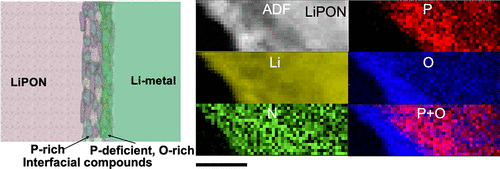当前位置:
X-MOL 学术
›
Nano Lett.
›
论文详情
Our official English website, www.x-mol.net, welcomes your
feedback! (Note: you will need to create a separate account there.)
Elucidating Interfacial Stability between Lithium Metal Anode and Li Phosphorus Oxynitride via In Situ Electron Microscopy
Nano Letters ( IF 9.6 ) Pub Date : 2020-12-18 , DOI: 10.1021/acs.nanolett.0c03438 Zachary D. Hood 1 , Xi Chen 2 , Robert L. Sacci 3 , Xiaoming Liu 4 , Gabriel M. Veith 3 , Yifei Mo 5 , Junjie Niu 2 , Nancy J. Dudney 3 , Miaofang Chi 4
Nano Letters ( IF 9.6 ) Pub Date : 2020-12-18 , DOI: 10.1021/acs.nanolett.0c03438 Zachary D. Hood 1 , Xi Chen 2 , Robert L. Sacci 3 , Xiaoming Liu 4 , Gabriel M. Veith 3 , Yifei Mo 5 , Junjie Niu 2 , Nancy J. Dudney 3 , Miaofang Chi 4
Affiliation

|
Li phosphorus oxynitride (LiPON) is one of a very few solid electrolytes that have demonstrated high stability against Li metal and extended cyclability with high Coulombic efficiency for all solid-state batteries (ASSBs). However, theoretical calculations show that LiPON reacts with Li metal. Here, we utilize in situ electron microscopy to observe the dynamic evolutions at the LiPON–Li interface upon contacting and under biasing. We reveal that a thin interface layer (∼60 nm) develops at the LiPON–Li interface upon contact. This layer is composed of conductive binary compounds that show a unique spatial distribution that warrants an electrochemical stability of the interface, serving as an effective passivation layer. Our results explicate the excellent cyclability of LiPON and reconcile the existing debates regarding the stability of the LiPON–Li interface, demonstrating that, though glassy solid electrolytes may not have a perfect initial electrochemical window with Li metal, they may excel in future applications for ASSBs.
中文翻译:

通过原位电子显微镜阐明锂金属阳极与锂磷氧氮化物之间的界面稳定性
氧氮化锂磷(LiPON)是为数不多的固态电解质之一,对所有固态电池(ASSB)都显示出对锂金属的高稳定性以及可扩展的循环性和高库仑效率。然而,理论计算表明,LiPON与锂金属发生反应。在这里,我们就地利用电子显微镜观察在接触和偏压下LiPON-Li界面的动态演变。我们发现,LiPON-Li界面在接触时会形成薄的界面层(约60 nm)。该层由导电的二元化合物组成,这些化合物具有独特的空间分布,可保证界面的电化学稳定性,是有效的钝化层。我们的结果证明了LiPON的出色循环性,并调和了有关LiPON-Li接口稳定性的现有争论,表明尽管玻璃状固体电解质可能没有与Li金属完美的初始电化学窗口,但它们可能在ASSB的未来应用中表现出色。
更新日期:2021-01-13
中文翻译:

通过原位电子显微镜阐明锂金属阳极与锂磷氧氮化物之间的界面稳定性
氧氮化锂磷(LiPON)是为数不多的固态电解质之一,对所有固态电池(ASSB)都显示出对锂金属的高稳定性以及可扩展的循环性和高库仑效率。然而,理论计算表明,LiPON与锂金属发生反应。在这里,我们就地利用电子显微镜观察在接触和偏压下LiPON-Li界面的动态演变。我们发现,LiPON-Li界面在接触时会形成薄的界面层(约60 nm)。该层由导电的二元化合物组成,这些化合物具有独特的空间分布,可保证界面的电化学稳定性,是有效的钝化层。我们的结果证明了LiPON的出色循环性,并调和了有关LiPON-Li接口稳定性的现有争论,表明尽管玻璃状固体电解质可能没有与Li金属完美的初始电化学窗口,但它们可能在ASSB的未来应用中表现出色。











































 京公网安备 11010802027423号
京公网安备 11010802027423号